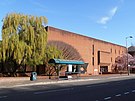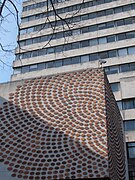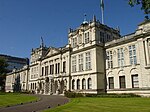Cardiff University
Welsh: Prifysgol Caerdydd | |
| File:CardiffUniversityCrest.png Coat of arms of Cardiff University | |
| Motto | Welsh: Gwirionedd Undod A Chytgord |
|---|---|
Motto in English | Truth Unity and Harmony |
| Type | Public |
| Established | 1883 (as University College of South Wales and Monmouthshire) 1997 (granted degree awarding powers) |
| Endowment | £27.5 million (2013)[1] |
| Chancellor | Martin Evans |
| President | Colin Riordan |
| Vice-Chancellor | Colin Riordan |
| Students | 27,774[2] |
| Undergraduates | 20,611[2] |
| Postgraduates | 7,133[2] |
| Location | , 51°29′16″N 3°10′44″W / 51.4877°N 3.1790°W |
| Campus | Urban |
| Colours | |
| Affiliations | Russell Group EUA Universities UK |
| Website | cardiff.ac.uk |
Cardiff University (Welsh: Prifysgol Caerdydd) is a public research university located in Cardiff, Wales, United Kingdom. The University is composed of three colleges: Arts, Humanities and Social Sciences; Biomedical and Life Sciences; and Physical Sciences and Engineering.
Founded in 1883 as the University College of South Wales and Monmouthshire, it became one of the founding colleges of the University of Wales in 1893, and in 1999 became an independent University awarding its own degrees. It is the second oldest university in Wales. It is a member of the Russell Group of leading British research universities.[3] The university is consistently recognised as providing high quality research-based university education and is ranked 123 of the world's top universities by the QS World University Rankings, as well as achieving the highest student satisfaction rating in the 2013 National Student Survey for universities in Wales.[4]
The University has an undergraduate enrollment of 20,611 and a total enrollment of 27,774, making it one of the largest universities in Wales. The Cardiff University Students' Union works to promote the interests of the student body within the University and further afield. The University's sports teams compete in the British Universities and Colleges Sport (BUCS) leagues.
History
Founding

Discussions regarding the founding of a college in South Wales began as early as 1879, when a group of Welsh and English MPs urged the government to consider the poor provision of higher and intermediate education in Wales and 'to consider the best means of assisting any local effort which may be made for supplying such deficiency'.[5]
In October 1881 Gladstone's government appointed a departmental committee to conduct 'an enquiry into the nature and extent of intermediate and higher education in Wales'. The committee was chaired by Lord Aberdare and consisted of Viscount Emlyn, Reverend Prebendary H. G. Robinson, Henry Richard, John Rhys and Lewis Morris.[6] The Aberdare report, as it came to be known, took evidence from a wide range of sources and over 250 witnesses and recommended a college for North and South Wales each, the southern to be located in Glamorgan and the Northern to be the already established University College of Wales in Aberystwyth (now Aberystwyth University). The committee cited the unique Welsh national identity and that many students in Wales could not afford to travel to University in England or Scotland. Furthermore it advocated for a national degree-awarding university for Wales, composed of the regional colleges. It also recommended that the colleges should be unsectarian in nature and that they should exclude the teaching of theology.[6][7]

After this recommendation was published the Cardiff Corporation attempted to secure the location of the college as Cardiff, and on 12 December 1881 formed a University College Committee to aid the matter.[8] A competition arose between Swansea and Cardiff about where the college should be located and on the 12th March 1883, after a period of arbitration, the location was set as Cardiff.[8] The case for Cardiff was strengthened by stressing the need to take account of the interests of Monmouthshire, at that time not legally considered part of Wales, as well as the greater sum of money received by Cardiff in support of the college, through a public appeal that raised £37,000, and a number of private donations, notably from the Lord Bute and Lord Windsor.[9][10] In April Lord Aberdare was appointed as the College's first president.[8] The possible locations considered for the college included Cardiff Arms Park, Cathedral Road or Moria Terrace, Roath, before the site of the Old Royal Infirmary buildings on Newport Road were chosen.[8]
The University College of South Wales and Monmouthshire opened on 24 October 1883, offering studies in Biology, Chemistry, English, French, German, Greek, History, Latin, Mathematics & Astronomy, Music, Welsh, Logic & Philosophy and Physics. The University College was incorporated by Royal Charter the following year, this charter was the first in Wales to allow the enrollment of women, and specifically forbid religious tests for entry.[10] John Viriamu Jones was appointed as the University's first Principal, at age 27. As Cardiff was not an independent university and could not award its own degrees, it prepared its students for the examinations of the University of London or further study at Oxford or Cambridge.[11]
In 1888 the university college at Cardiff and University College of North Wales (now Bangor University) proposed to University College Wales (at Aberystwyth) a joint action to obtain a university charter for Wales, modeled on that of Victoria University, a confederation of new universities in Northern England. This charter was granted to the new University of Wales in 1893, allowing the colleges to award degrees as members of this institution. The chancellor was set ex officio as the Prince of Wales, and the position of operational head would rotate among heads of the colleges.[10]
In 1885, Aberdare Hall opened as the first hall of residence, allowing women access to the university. This moved to its current site in 1895, but remains a single-sex hall. 1904 saw the appointment of the first female professor in the UK, Millicent McKenzie.
Expansion

In 1905, Architect W.D. Caroe commenced building work on the main building, and it was completed in many stages, the first in 1909. Money ran short for this project, however, and although the side-wings were completed in the 1960s the planned Great Hall has never been built. Caroe sought to combine the charm and elegance of his former college (Trinity College, Cambridge) with the picturesque balance of many of the University of Oxford colleges.
In 1931, the School of Medicine, which had been founded as part of the college in 1893 when the Departments of Anatomy, Physiology, Pathology, Pharmacology were founded, was split off to form the University of Wales College of Medicine. In 1972, the college lost the name it had retained for ninety years and was renamed University College, Cardiff.[12]
In 1988, financial considerations led to the merger of University College, Cardiff with the University of Wales Institute of Science and Technology, UWIST, forming the University of Wales College, Cardiff. The Principal of the new institution was Sir Aubrey Trotman-Dickenson, who had been principal of UWIST. Following changes to the constitution of the University of Wales in 1996, this became the University of Wales, Cardiff.
In the early 1990s, the university's computer systems served as the home for The Internet Movie Database.[13]
As an Independent University
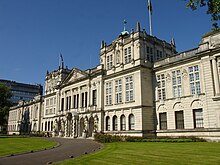
In 1997, the college was granted full independent degree awarding-powers by the Privy Council (though, as a member of the University of Wales it could not begin using them) and in 1999 the public name of the university was changed to Cardiff University.
In 2002, ideas were floated to re-merge Cardiff with the University of Wales College of Medicine following the publication of the Welsh Assembly Government's review of higher education in Wales. This merger became effective on 1 August 2004, on which date Cardiff University ceased to be a constituent institution of the University of Wales and became an independent "link institution" affiliated to the federal University. The process of the merger was completed on 1 December 2004 when the Act of Parliament transferring UWCM's assets to Cardiff University received Royal Assent. On 17 December it was announced that the Privy Council had given approval to the new Supplemental Charter and had granted university status to Cardiff, legally changing the name of the institution to Cardiff University. Cardiff awarded University of Wales degrees to students admitted before 2005, but these have been replaced by Cardiff degrees.
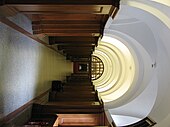
In 2005, The Wales College of Medicine, which is part of the University, launched the North Wales Clinical School in Wrexham in collaboration with the North East Wales Institute of Higher Education in Wrexham and the University of Wales, Bangor and with the National Health Service in Wales. This has been funded with £12.5 million from the Welsh Assembly[14] and will lead to the trebling of the number of trainee doctors in clinical training in Wales over a four-year period.
The university also has a popular Centre for Lifelong Learning which has been teaching a wide range of courses to the public for over 125 years.[15] In July 2009, the University announced it was ending the teaching of over 250 humanities courses at the centre making over 100 staff redundant. The University has since reintroduced a number of humanities courses for a trial period beginning in 2010.[16]
In June 2010, the University launched three new Research Institutes,[17] each of which offers a new approach to a major modern research issue. They are the Cancer Stem Cell Research Institute, the Sustainable Places Research Institute, and the Neurosciences & Mental Health Research Institute.
Organisation and academic profile
Schools and colleges
The 26 academic schools of the University are divided into three colleges: Arts, Humanities and Social Sciences; Biomedical and Life Sciences; and Physical Sciences.
|
College of Arts, Humanities and Social Sciences
|
College of Biomedical and Life Sciences
|
College of Physical Sciences
|
Cardiff also has a University Graduate College that brings together the work of four previous discipline-based Graduate Schools and the postgraduate research activity of the University's Graduate Centre.
Finances

In the financial year ended 31 July 2012, Cardiff University had a total net income of £425.54 million.[18] Key sources of income included £87.65 million from research grants and contracts, £117.36 million from Funding Council grants, £123.84 million from tuition fees and support grants and £3.17 million from endowment and investment income.[18] During the 2011/12 financial year Cardiff had a capital expenditure of £14.29 million.
At 31 July 2012 Cardiff had endowments of £25.58 million and total net assets of £402.86 million.[18]
Rankings

| National rankings | |
|---|---|
| Complete (2025)[19] | 23 |
| Guardian (2025)[20] | 26 |
| Times / Sunday Times (2025)[21] | =27 |
| Global rankings | |
| ARWU (2024)[22] | 101-150 |
| QS (2025)[23] | 123 |
| THE (2025)[24] | 201-225 |
Cardiff University continues the tradition of all three of its former institutions in providing high quality research-based education in Wales, as shown in its five-year standing as the best centre of excellence in Wales in the Sunday Times League Tables. Cardiff is also the only university in Wales to be a member of the Russell Group of Research Intensive Universities. Cardiff is by far the strongest research-focused university in Wales. In the 2008 Research Assessment Exercise, 33 out of the 34 research areas submitted by the University for assessment were shown to be undertaking research that includes world-leading work.
Cardiff has two Nobel Laureates on its staff, Sir Martin Evans and Robert Huber.[25] A number of Cardiff University staff have been elected as Fellows of the Royal Society, these include Graham Hutchings FRS, professor of Physical Chemistry and Director of the Cardiff Catalysis Institute, School of Chemistry[26] and Ole Holger Petersen CBE FRS, MRC Professor and Director of Cardiff School of Biosciences.[27]
In 2013, Cardiff University was ranked as one of the best universities in the UK for supporting LGB students by the charity Stonewall in its annual Gay by Degree guide. The University was one of only two universities in the UK and the only university in Wales to achieve top marks in a Stonewall checklist of priorities for LGB students.[28]
The University has also won four Queen's Anniversary Prizes for Higher & Further Education. The most recent award was won in 2009 by the University's Violence & Society Research Group.
Cardiff University was ranked 188th in Best Global Universities internationally and 19th nationally.[29]
Campus
Academic facilities
The University's academic facilities are centred around Cathays Park in central Cardiff,[30] which contains the University's main building, housing administrative facilities and the science library;[31] the Bute building, which contains the Welsh School of Architecture[32] and the Cardiff School of Journalism, Media and Cultural Studies;[33] the Glamorgan building, which houses the Cardiff Schools of Planning and Geography and Social Sciences,[34] the Redwood Building, which houses the School of Pharmacy and Pharmaceutical Sciences;[35] the law building which houses the Cardiff Law School;[36] and the biosciences building, which provides facilities for both biosciences and medical teaching.[37]
A number of the University's academic facilities are also located at the Heath Park campus which is based at the University Hospital of Wales, this contains the Cardiff University School of Medicine, the School of Nursing and Midwifery Studies, the School of Dentistry, the School of Healthcare Studies and the School of Optometry & Vision Sciences.[30]
| Buildings of Cardiff University |
|---|
|
Athletic facilities
The majority of the University's sports facilities are located at the sports training village in the Talybont Halls complex. This includes facilities for football, badminton, basketball, tennis, hockey and gym facilities.[38] Additional gym facilities and squash courts are located at the university fitness and squash centre, near the city centre campus at Cathays Park.[39] Extensive playing fields for Rugby, football and lacrosse are located at the University playing fields near Llanrumney.[40] The University also utilises the nearby Millennium Stadium for rugby fixtures such as the annual varsity tournament.[41]
Student life
Student accommodation

The University maintains fourteen student halls and a number of student houses throughout the city of Cardiff; providing a total of 5,362 student places in accommodation.[2] They are in a variety of architectural styles and ages, from the Gothic Aberdare Hall, built in 1895, to the modern Talybont Halls, built in 1995. All first-year students are guaranteed a place in Halls.[42] The Cardiff University Halls are:
- Aberconway Hall
- Aberdare Hall
- Cartwright Court
- Colum Hall
- Gordon Hall
- Roy Jenkins Hall
- Senghennydd Court
- Senghennydd Hall
- Talybont Halls
- University Hall
Students' union

The Cardiff University Students' Union is a student-run organisation that aims to promote student interests both within the University and further afield. The Cardiff University Students' Union building is near Cathays Park, next to Cathays railway station. It has shops, a nightclub and the studios of Xpress Radio and Gair Rhydd, the student newspaper. It is democratically controlled by the student body through the election of eight full-time officers who manage the running of the Union.[43] The Union provides a range of services, including a number of cafes, bars and shops, as well as advice, training and representation. The Union is an affiliated member of the National Union of Students.[44]
Student groups and societies
The Union also supports over 150 other clubs and societies across a wide range of interests,[45] including: Cardiff University Debating Society,[46] and Act One, the student dramatic society.[47] All clubs offer opportunities for beginners and the more experienced students.
Student Volunteering Cardiff is a registered charity run by Cardiff students that promotes and enables volunteering by the student body.[48]
Media

The Union provides facilities and support for several student media groups, including: gair rhydd, an award-winning, free student newspaper that is released every Monday of term;[49] Quench, a monthly arts and lifestyle magazine covering a range of issues;[50] Xpress Radio, the student radio station;[51] and CUTV, the student television channel.[52]
Athletics
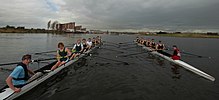
The Cardiff University Athletic Union is the body that supports student sport at Cardiff, it oversees more than 60 competitive and non-competitive sports clubs, many of which compete in the British Universities and Colleges Sport league.[53] The University's Ice Hockey team, the Cardiff Redhawks (which also recruits players from other Welsh universities) competes in the British Universities Ice Hockey Association leagues.[54]
The university's sports teams also take part in the annual Welsh Varsity against Swansea University, which includes the Welsh Boat Race, and several other sporting competitions.[55]
Cardiff participates in British Universities and Colleges Sport which manages a sporting framework of competitive fixtures and events for over 150 institutions around the UK. Cardiff registers nearly 100 teams in the various leagues and competitions each year and sees students travelling around the country to represent Cardiff University. In 2013 Cardiff team achieved 15th position overall across the 50 different sports hosting events.
Insignia and other representations
Motto
Cardiff University's motto is Gwirionedd, Undod a Chytgord. The Welsh motto is translated as Truth, Unity and Concord or Truth, Unity and Harmony and is taken from the prayer for the Church militant as it appears in the 1662 Book of Common Prayer.[56]
Coat of arms
Cardiff University's current coat of arms was granted by the College of Arms in 1988 following the merger of University College Cardiff and the University of Wales Institute of Science and Technology.[57] The coat of arms incorporates features from the heralds of both of the former institutions. The three silver chevrons on a red background are derived from the arms of Iestyn ap Gwrgant, an 11th-century ruler of the Welsh Kingdom of Morgannwg that encompassed Glamorgan and Monmouthshire. The open book signifies learning; on it are the crescent and annulet, marks of cadence that indicate that University College Cardiff was the second of the University of Wales' institutions, and that the Wales Institute of Science and Technology was the fifth.[58]
A notable feature of the arms are the supporters, which in heraldry are rarely granted to universities. The supporters are an angel from University College Cardiff and a Welsh Dragon from the Wales Institute of Science and Technology. The crest is a Welsh dragon in the stance of a lion; it stands on the helmet. Both the dragon and the helmet are distinguished by being front-facing rather than in profile as is more usually found in Welsh heraldry.[58]
Notable alumni and faculty
Heads of state and government

- Baron Roy Jenkins, former President of the European Commission and Chancellor of the University of Oxford (did not graduate)
Politics
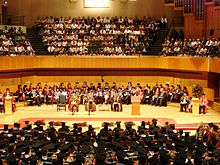

- Christine Chapman, AM for Cynon Valley
- Wayne David, MP for Caerphilly and Shadow Minister for Europe
- Guto Harri, Communications Director for the Mayor of London Boris Johnson's administration at London City Hall
- Elin Jones, AM for Ceredigion and Minister for Rural Affairs
- Sir Emyr Jones Parry, former British Permanent Representative to the United Nations, (2003–2007[59])
- Glenys Kinnock, former MEP and former UK Foreign Office Minister
- Neil Kinnock, Leader of Her Majesty's Most Loyal Opposition (2 October 1983– 18 July 1992)
- Mike Hedges AM for Swansea East
- Hilary Marquand, former MP for Cardiff East
- Robert Minhinnick, co-founder of Friends of the Earth (Cymru)[60]
- Christopher Walter Monckton, 3rd Viscount Monckton of Brenchley, advisor to Margaret Thatcher
- Craig Oliver, current Conservative Party Director of Communications
- Bill Rammell, former MP for Harlow
- General Sir David Richards, current Chief of the Defence Staff
- Brian Wilson, former MP for Cunninghame North
Academia
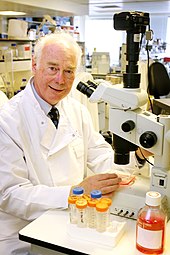

- Miguel Alcubierre, Mexican theoretical physicist
- Rudolf K. Allemann, Swiss biochemist
- Robin Attfield, philosopher
- Yehuda Bauer, Professor of Holocaust Studies at the Avraham Harman Institute of Contemporary Jewry at the Hebrew University of Jerusalem
- Leszek Borysiewicz, Vice-Chancellor of the University of Cambridge
- The Rt Revd Gregory Cameron, Bishop of St Asaph
- Sheila Cameron QC, lawyer and ecclesiastical judge
- Archie Cochrane, pioneer of scientific method in medicine
- Peter Coles, Professor of Astrophysics
- The Rt Revd Paul Colton, Bishop of Cork, Cloyne and Ross
- Alun Davies, bioscientist
- Huw Dixon, economist
- Stephen Dunnett, neuroscientist
- Sir Martin Evans, Nobel Prize for Medicine[61] 2007
- Robert Huber, Professor of Chemistry, Nobel Laureate – The Nobel Prize in Chemistry1988[62][63]
- John Loughlin, Professor of Politics
- Vaughan Lowe QC, (Chichele Professor of Public International Law in the University of Oxford
- Patrick Minford, Professor of Applied Economics
- John Warwick Montgomery – American lawyer and theologian; Distinguished Research Professor of Philosophy and Christian Thought at Patrick Henry College.[64]
- Christopher Norris, literary critic
- Sir Keith Peters, FRS PMedSci (Regius Professor of Physic in the University of Cambridge)
- Alice Roberts, clinical anatomist and osteoarchaeologist
- H. W. Lloyd Tanner, Professor of Mathematics and Astronomy (1883–1909)
- The Rt Revd Dominic Walker, OGS, Bishop of Monmouth
- Keith Ward, philosopher, Gresham Professor of Divinity, Gresham College
- Chandra Wickramasinghe, Professor of Applied Mathematics
- Rheinallt Nantlais Williams, academic
Business
- Stephen Bird, Chief Executive Officer of Citibank consumer banking in Asia Pacific
- Spencer Dale, Chief economist, Bank of England.
- Andrew Gould, Chairman and former CEO, Schlumberger Limited[65]
- Martin Lewis, personal finance journalist, television presenter and website entrepreneur
- Dame Mary Perkins, Founder of Specsavers
Sport
- Nathan Cleverly, professional boxer and former WBO light heavyweight world champion
- Gareth Davies, former Wales and British and Irish Lions international rugby union player, and current chief executive of Cardiff Rugby Football Club
- Gerald Davies, former Wales and British and Irish Lions international rugby union player
- Mike Hall, former Wales and British and Irish Lions international rugby union player
- Steven Outerbridge, Bermudian cricketer
- Jamie Roberts, Wales and British and Irish Lions international rugby union player
- James Tomlinson, English cricketer
- Bradley Wadlan, Welsh cricketer
Arts and journalism

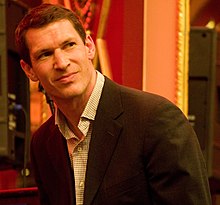
- Matt Barbet, journalist
- Manish Bhasin, journalist and television presenter
- Nick Broomfield, documentary filmmaker and receiver of the BAFTA Lifetime Achievement Award for Contribution to Documentary
- Philip Cashian, composer
- Rahul Kanwal, journalist and executive director Headlines Today.
- Suw Charman-Anderson, journalist and social software consultant.
- Adrian Chiles, television presenter
- Gillian Clarke, poet and receiver of the Queen's Gold Medal for Poetry
- Huw Edwards, journalist
- Ken Elias, artist/painter
- Max Foster, CNN Anchor, CNN Today[66]
- M. A. Griffiths, poet
- Julia Hartley-Brewer, journalist and television presenter
- Jiang Heping, Executive Director of the CCTV Sports Programming Centre and Controller of CCTV-5
- Tim Hetherington, photo-journalist and co-director of Academy Award-nominated Restrepo
- Alun Hoddinott, composer
- Karl Jenkins, composer
- Alan Johnston, journalist
- Riz Khan, journalist and television interviewer
- Bernard Knight, crime writer
- Simon Lane, one half of the popular internet show "The Yogscast"
- Siân Lloyd, television presenter
- Los Campesinos!, six piece indie pop band
- Philip Madoc, actor
- Paul Moorcraft, writer
- Sharon Morgan, actress
- Siân Phillips, actress
- Susanna Reid, television presenter
- James Righton, musician
- Arlene Sierra, composer
- Richard Tait, former BBC Governor and BBC trustee
- Craig Thomas, author
- Vedhicka, Indian actress
- Grace Williams, composer
See also
- List of universities in Wales
- List of modern universities in Europe (1801–1945)
- Education in Wales
- Russell Group
- Town and gown
References
- ^ "Financial Statements for the Year to 31 July 2013" (PDF). Cardiff University. p. 14. Retrieved 18 February 2014.
- ^ a b c d "Student Numbers". Retrieved 10 May 2013.
- ^ The Russell Group. Retrieved 3 September 2009.
- ^ "Record levels of student satisfaction". Retrieved 6 May 2013.
- ^ http://hansard.millbanksystems.com/commons/1879/jul/18/education-wales-resolution#S3V0247P0_18790718_HOC_65. Parliamentary Debates (Hansard). House of Commons. 18 July 1879.
{{cite book}}:|chapter-url=missing title (help) - ^ a b Evans, W.G. (1982–83). "The Aberdare Report and education in Wales, 1881". Welsh History Review. 11 (1–4): 150–152. Retrieved 18 September 2014.
{{cite journal}}: CS1 maint: date format (link) Cite error: The named reference "The Aberdare Report and education in Wales, 1881" was defined multiple times with different content (see the help page). - ^ Brown, Terry (April 1984). A HANDBOOK ON WELSH CHURCH DEFENCE BY THE BISHOP OF ST. ASAPH. DENBIGH: PRINTED BY C. COTTON AND CO., VALE STREET. Retrieved 18 September 2014.
- ^ a b c d Matthews, John Hobson (1905). 'Cardiff Council Minutes: 1881-3', Cardiff Records: volume 5. pp. 62–84. Retrieved 18 September 2014.
- ^ http://hansard.millbanksystems.com/commons/1884/jun/09/instruction-to-the-committee#S3V0288P0_18840609_HOC_11. Parliamentary Debates (Hansard). House of Commons. 9 June 1884.
{{cite book}}:|chapter-url=missing title (help) - ^ a b c MACLEAN, GEORGE EDWIN (1917). Studies in higher education in Ireland and Wales, with suggestions for universities and colleges in the United States. Washington DC: GOVERNMENT PRINTING OFFICE. p. 71. Retrieved 19 September 2014. Cite error: The named reference "Studies in higher education in Ireland and Wales, with suggestions for universities and colleges in the United States" was defined multiple times with different content (see the help page).
- ^ "Student Lists". Senate House Library. Retrieved 27 March 2013.
- ^ "Cardiff University", Higher Education Funding Council for Wales
- ^ "IMDb History".
- ^ "Health Minister opens North Wales Clinical School". Welsh Assembly Government. Retrieved 4 July 2008.
- ^ "New book celebrates 125 years of Lifelong Learning at Cardiff University=Cardiff University". Retrieved 16 May 2009.
- ^ "Humanities Courses".
- ^ "Cardiff creating three research institutes". WalesOnline. Retrieved 21 June 2010.
- ^ a b c "CARDIFF UNIVERSITY Annual Report and Financial Statements Year Ended 31 July 2012" (PDF). Cardiff University. Retrieved 5 September 2013.
- ^ "Complete University Guide 2025". The Complete University Guide. 14 May 2024.
- ^ "Guardian University Guide 2025". The Guardian. 7 September 2024.
- ^ "Good University Guide 2025". The Times. 20 September 2024.
- ^ "Academic Ranking of World Universities 2024". Shanghai Ranking Consultancy. 15 August 2024.
- ^ "QS World University Rankings 2025". Quacquarelli Symonds Ltd. 4 June 2024.
- ^ "THE World University Rankings 2025". Times Higher Education. 9 October 2024.
- ^ "School of Biosciences – Prof Robert Huber". Cardiff University. Retrieved 9 March 2011.
- ^ "Graham Hutchings FRS". Cardiff University. Retrieved 10 March 2011.
- ^ "Professor Ole Holger Petersen FRS". Cardiff University. Retrieved 10 March 2011.
- ^ "Cardiff University leads the way in Stonewall Gay by Degree guide". Retrieved 8 July 2013.
- ^ http://www.usnews.com/education/best-global-universities
- ^ a b "Heath Park". Retrieved 10 May 2013. Cite error: The named reference "Heath Park" was defined multiple times with different content (see the help page).
- ^ "Science Library". Retrieved 10 May 2013.
- ^ "Architecture school location". Retrieved 10 May 2013.
- ^ "Journalism school location". Retrieved 10 May 2013.
- ^ "Social Sci location". Retrieved 10 May 2013.
- ^ "Pharm location". Retrieved 10 May 2013.
- ^ "Law Location".
{{cite web}}:|access-date=requires|url=(help); Missing or empty|url=(help) - ^ "Bio sci location". Retrieved 16 June 2013.
- ^ "Sports training village". Retrieved 13 May 2013.
- ^ "Fitness and squash". Retrieved 13 May 2013.
- ^ "Playing fields". Retrieved 13 May 2013.
- ^ "Rugby Varsity". Retrieved 8 July 2013.
- ^ "Residences" (PDF). Retrieved 10 May 2013.
- ^ "Union Officers".
- ^ "NUS member". Retrieved 15 May 2013.
- ^ "Cardiff Societies". Retrieved 15 May 2013.
- ^ "Debating society". Retrieved 15 May 2013.
- ^ "Act one society". Retrieved 15 May 2013.
- ^ "Student Volunteering Cardiff". Retrieved 15 May 2013.
- ^ "gair rhydd paper". Retrieved 15 May 2013.
- ^ "Quench magazine". Retrieved 15 May 2013.
- ^ "Xpress radio". Retrieved 15 May 2013.
- ^ "CUTV". Retrieved 15 May 2013.
- ^ "Athletic union". Retrieved 15 May 2013.
- ^ "Cardiff Redhawks". Retrieved 11 May 2013.
- ^ "Welsh Varsity". Retrieved 10 May 2013.
- ^ Cardiff Motto. "Cardiff Motto". Retrieved 1 July 2013.
- ^ "History of Cardiff University". Retrieved 25 August 2013.
- ^ a b "Cardiff University coat of arms". Retrieved 25 August 2013.
- ^ "Former Permanent Representatives". United Kingdom Mission to the United Nations. Retrieved 4 March 2011.
- ^ "Robert Minhinnick". British Council. Retrieved 4 March 2011.
- ^ "The Nobel Prize in Physiology or Medicine 2007". Nobelprize.org. Retrieved 9 March 2011.
- ^ "Nobel laureate joins University". Cardiff University. Retrieved 4 July 2008.
- ^ "The Nobel Prize in Chemistry 1988". The Nobel Foundation. Retrieved 4 July 2008.
- ^ "JWM's WEB SITE". Retrieved 10 September 2012.
- ^ "Schlumberger CEO to retire, remains as chairman". Forbes. Retrieved 1 August 2011.
{{cite news}}: Unknown parameter|deadurl=ignored (|url-status=suggested) (help) [dead link] - ^ "CNN International – Anchors & Reporters – Max Foster". CNN International. Retrieved 4 March 2011.

